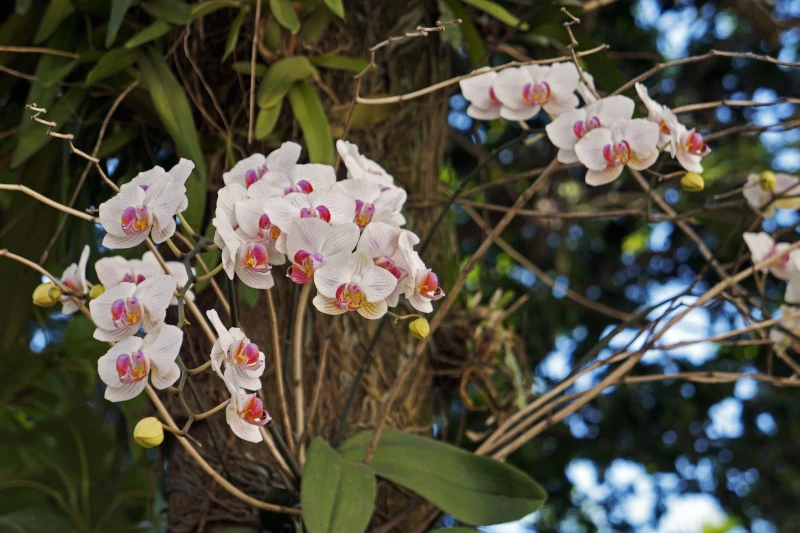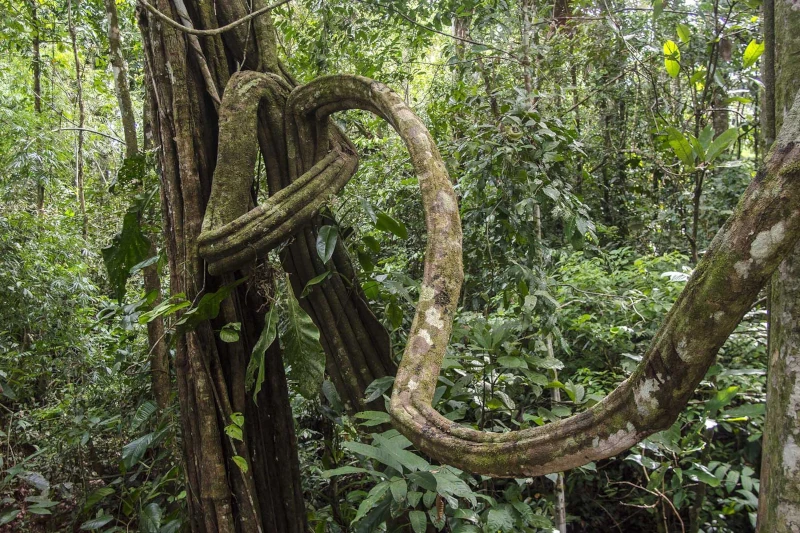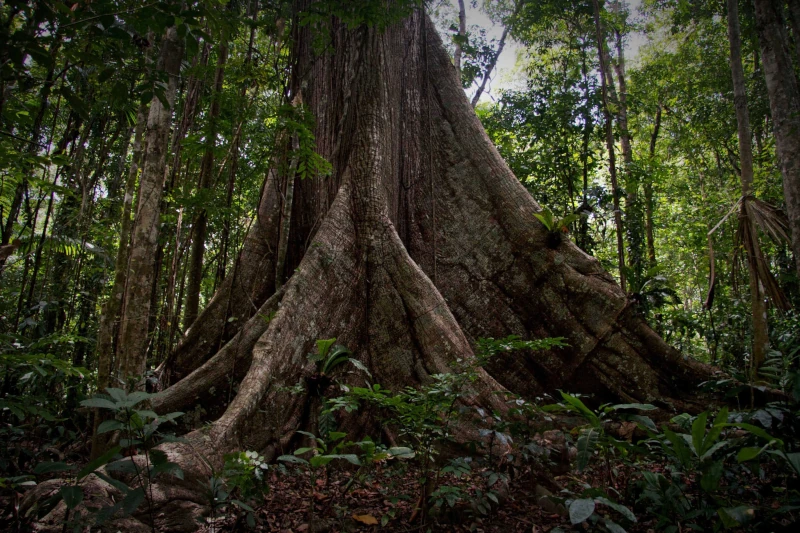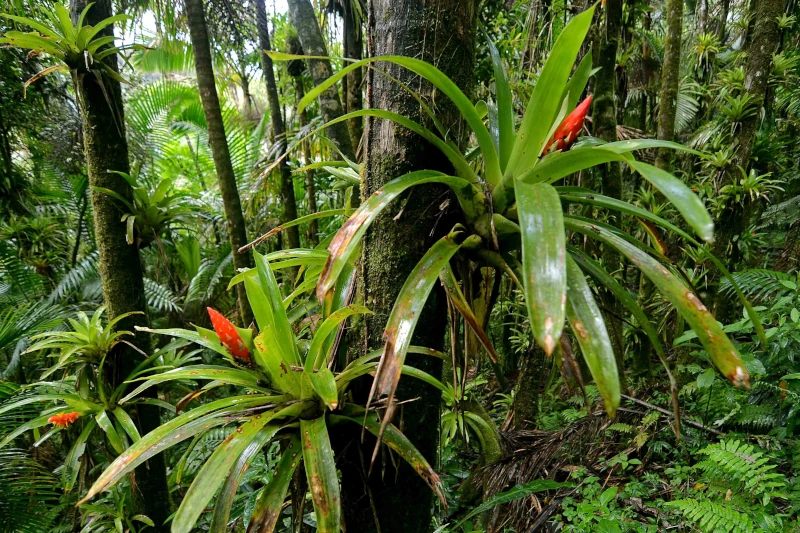In this article, we’ll guide you through some of the most captivating plants you might encounter in the tropical rainforest around South America, offering insights into their unique adaptations and roles within this thriving ecosystem. From the towering giants that dominate the skyline to the tiniest flowers that thrive in the underbrush, each plant tells a story of survival and adaptation. With this knowledge, your rainforest adventure will not only be a feast for the eyes but a journey of discovery into the wonders of plant life.
Tropical rainforests are nature’s masterpieces, home to an astonishing diversity of life forms. Covering only about 6% of Earth’s surface, they harbor more than half of the world’s plant and animal species. This incredible biodiversity is sustained by the rainforest’s unique climate, characterized by high humidity and consistent warm temperatures, creating an ideal environment for a vast array of plants. The interplay of sunlight filtering through the dense canopy and the constant moisture from frequent rains creates a thriving habitat where life flourishes year-round.
The dense canopy of the rainforest acts like a protective umbrella, capturing sunlight and moisture, which fuels the life below. Beneath this green roof, a multi-tiered ecosystem thrives, with each layer supporting different forms of life. This structured layering allows for an astonishing variety of flowering plants to coexist, each adapted to its unique niche. Such diversity is not just a spectacle to behold but a crucial component of global ecological health, influencing everything from carbon storage to weather patterns.
Plants in the tropical rainforest are not just beautiful; they play crucial roles in the ecosystem. They provide food and habitat for countless species, contribute to the global oxygen supply, and even influence weather patterns. The dense foliage acts as Earth’s lungs, absorbing carbon dioxide and releasing oxygen through photosynthesis. Understanding the flora of these regions offers a deeper appreciation for their ecological significance. Each plant, whether a towering rubber tree or a delicate fern, plays a part in maintaining the ecosystem’s health and balance.
Moreover, plants in the rainforest are a treasure trove of resources, offering medicinal properties that have been used for centuries by indigenous people like the Dragon’s blood or the Ayahuasca in spiritual terms. From the quinine used to treat malaria to the rosy periwinkle, which has led to cancer treatment breakthroughs, these plants are vital to human health. By appreciating their ecological roles and potential benefits, we can foster a greater commitment to conserving these irreplaceable resources.
The allure of tropical rainforests is not only in their sheer abundance of life but in the remarkable variety of plants you might encounter during your exploration. These plants are not just survivors but masters of adaptation, each with a unique story. As you journey deeper into the forest, you’ll discover a world where evolution has equipped plants with incredible tools to thrive in challenging conditions.

Epiphytes are plants that grow on other plants, usually large trees, rather than in soil. They are a common sight in rainforests, taking advantage in the competition for sunlight available in the upper layers of the forest. Orchids and bromeliads are two popular examples of epiphytes you might see clinging to tree branches. Their vibrant blooms add a splash of color to the green canopy. These plants have specialized roots that absorb moisture and nutrients from the air, enabling them to thrive high above the forest floor.
Epiphytes play a critical role in the rainforest by creating microhabitats for a variety of species. They provide shelter and food for insects, birds, and other small animals, contributing to the complex web of life within the forest. Their presence adds layers to the ecosystem, demonstrating the intricate interdependence of rainforest inhabitants. Observing these plants offers a glimpse into the delicate balance of life that defines these vibrant ecosystems.

Lianas are woody vines that wind their way up tree trunks to reach the sunlight. They are essential to the rainforest structure, providing pathways for arboreal animals like monkeys and sloths. Their strong, flexible stems can stretch over vast distances, making them an integral part of the Amazon jungle landscape. Lianas contribute to the forest’s structural complexity, linking trees and creating networks that support diverse forms of life.
Lianas also play a role in the forest’s dynamics by competing with Rainforest trees for light and resources. Their growth can be both beneficial and challenging, as they help maintain biodiversity but can also weigh down trees, affecting their growth. The presence of lianas illustrates the competitive yet symbiotic nature of rainforest life, where survival hinges on both cooperation and competition.
The kapok tree is one of the rainforest giants, towering above the canopy. Its massive trunk can reach up to 3 meters in diameter, and it plays a vital role in the ecosystem by providing food and shelter for numerous species. The tree’s large, buttress roots are not just for support; they also help the tree absorb nutrients in the nutrient-poor rainforest soil. These roots stabilize the tree and prevent soil erosion, showcasing the tree’s adaptability to its environment.
The kapok tree’s towering presence is a beacon of biodiversity, hosting a myriad of life forms within its branches. Birds, insects, and mammals find refuge and food among its leaves and flowers, while its seeds, encased in fluffy fibers, are dispersed by the wind, ensuring the tree’s propagation. The kapok tree exemplifies the rainforest’s intricate web of life, where every organism plays a part in sustaining the ecosystem.

The plants in tropical rainforests have developed unique adaptations to survive in their challenging environment. Understanding these adaptations can deepen your appreciation of the intricate balance of life in the jungle. Each adaptation is a testament to the resilience and ingenuity of nature, allowing plants to flourish in an environment that is both competitive and nurturing.
Amazon Rainforest plants have leaves with pointed tips, known as drip tips, which help water run off quickly, preventing mold and fungal growth in the humid environment. These drip tips are vital for the plants’ health, ensuring leaves remain dry and photosynthesis is not hampered. Additionally, waxy surfaces on leaves reduce water loss and repel excess moisture. This adaptation helps plants manage the high humidity and frequent rainfall, maintaining their internal water and nutrients balance.
These features are not just about survival but are crucial for the plants’ reproductive success. By keeping their leaves free from excess water, plants can ensure that their flowers and seeds are not damaged, allowing them to reproduce effectively. Observing these adaptations in action provides insight into the complex strategies plants use to thrive in their lush, green world.

To avoid becoming a snack, some of the strangest plants have developed ingenious defense mechanisms. Certain species can blend into their surroundings, while others use thorns, toxic chemicals, or tough leaves to deter herbivores. These strategies are essential for survival in a densely populated ecosystem where competition for resources is fierce. Camouflage allows plants to hide in plain sight, while chemical defenses can make them unpalatable or toxic to would-be predators.
These adaptations highlight the constant evolutionary arms race between plants and herbivores. Plants must continuously adapt to survive, while herbivores evolve to overcome these defenses. This dynamic interaction drives the diversity and complexity of rainforest ecosystems, illustrating the relentless push and pull of natural selection.
For those planning a visit to the Amazon rainforest,preparation is key. Here are some tips to make the most of your adventure. With the right planning, your journey can be both thrilling and educational, providing a deeper understanding of these incredible environments.
Rainforests are spread across the globe, with notable examples in the Amazon Basin, Central Africa, Southeast Asia, and the Pacific Islands. Each region offers unique Rainforest species and experiences. Researching your chosen destination’s specific ecosystem will enhance your understanding and enjoyment. Consider factors like accessibility, climate, and the types of flora and fauna you wish to see when selecting your destination.
Each Tropical biodiversity hotspot in the Amazon river has its own character, shaped by its geographical location and climatic conditions. Whether you’re drawn to the Amazon’s vast canopy, Borneo’s exotic wildlife tours, or the rich culture of Central African rainforests, each location promises a distinct and unforgettable experience. Understanding these differences helps tailor your journey to your interests, ensuring a rewarding adventure. Moreover in Peru the Tambopata National Reserve is one of the most important hotspots in South America to find unique flora specimens.
Pack light, breathable clothing to cope with the humidity, and don’t forget a sturdy pair of hiking boots. A waterproof jacket is essential, as rain is frequent in these environments. Equip yourself with a good camera and binoculars to capture the stunning sights of the rainforest. In addition to these essentials, consider packing insect repellent, a hat, and a reusable water bottle to stay comfortable and hydrated during your explorations.
Preparation extends beyond clothing and gear. Familiarize yourself with any health precautions, such as vaccinations or medications, that may be necessary for travel to tropical regions. By planning ahead, you can focus on the wonders of the rainforest without worrying about logistical challenges.
Consider hiring a local guide who can offer insights into the flora and fauna you encounter. Guides can provide valuable information about the ecosystem and cultural context that enrich your understanding of the rainforest environment. Their expertise can lead you to hidden gems within the forest and enhance your appreciation of the intricate relationships between species.
Engaging with local communities and participating in guided tours can also support conservation efforts. By choosing eco-friendly operators and respecting local customs, you contribute to preserving the rainforest’s beauty for future generations. This mindful approach ensures that your adventure leaves a positive impact on both the environment and its people.

As travelers, it’s crucial to respect and protect the natural wonders we explore. Rainforests are under threat from deforestation, climate change, and human activities. Supporting conservation efforts and practicing sustainable tourism can help preserve these vital ecosystems for future generations. By becoming informed about the challenges rainforests face, we can play a part in their preservation.
Engaging with and supporting local indigenous communities can have a positive impact. Many indigenous peoples have lived in harmony with the rainforest for generations and can offer unique perspectives on its importance and conservation. By supporting local businesses and initiatives, travelers can contribute to the economic well-being of these communities, encouraging sustainable practices that protect the rainforest.
Empowering local communities to lead conservation efforts is crucial for long-term success. Their knowledge and traditions are invaluable resources in maintaining the health of the rainforest. By fostering partnerships and promoting education, we can help ensure that these communities continue to thrive alongside the ecosystems they safeguard.
Exploring the vibrant world of tropical rainforests is an unforgettable experience that offers a glimpse into the Earth’s incredible biodiversity hotspot. By understanding and appreciating the unique plants you must see that inhabit these lush ecosystems, you can deepen your connection to the natural world and contribute to its preservation. Each visit to a rainforest is an opportunity to witness the beauty and complexity of nature up close.
Whether you’re a corporate executive seeking a refreshing getaway, a photographer in search of picturesque landscapes, or an academic researcher gathering insights, the tropical rainforest promises to be a Botanist paradise. This diverse environment offers something for everyone, from the casual observer to the dedicated naturalist.
So pack your bags, grab your camera, and get ready to immerse yourself in the breathtaking beauty of the rainforest’s flora on your next adventure. Safe travels! As you journey through this living tapestry, may you find inspiration and a renewed commitment to protecting the wonders of our planet.